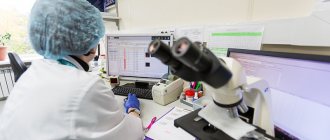With the help of prolactin, breasts form and grow (the hormone is also responsible for the development of ducts), and milk is produced after the baby is born. In addition, ovulation depends on prolactin. The hormone is involved in the regulation of progesterone production: its increase leads to a decrease in progesterone production and, as a result, to a slowdown in ovulation processes.
During pregnancy, prolactin levels increase significantly. This is a normal process. After childbirth, during lactation, it remains high (although compared to pregnancy, of course, it falls). This explains the very low chance of pregnancy during breastfeeding. But still, if the cycle is restored, breastfeeding cannot be considered a reliable method of contraception.
Outside of pregnancy, prolactin levels fluctuate depending on the day of the menstrual cycle. A strong and sustained increase that is not associated with bearing or feeding a child has a negative effect on the body. This condition is called hyperprolactinemia.
The role of prolactin in the female body
Under the influence of prolactin in women, colostrum matures, which turns into mature milk.
Effects of mammotropin:
- enhances colostrum production;
- participates in the growth and development of the mammary glands;
- helps to increase the number of lobules in the chest and ducts;
- ensures that the glands are filled with milk until subsequent feedings;
- in pregnant women, regulates the amount and composition of amniotic fluid;
- affects the synthesis of progesterone by the corpus luteum during pregnancy;
- responsible for slowing down ovulation and new conception;
- prevents pregnancy and the onset of menstruation during lactation;
- ensures immunological tolerance of the embryo during pregnancy;
- when prolactin levels increase, an analgesic effect is observed; when it decreases, sensitivity to pain increases;
- participates in the formation of the internal lining of the pulmonary alveoli;
- slows down the secretion of gonadotropin-releasing factor and folliculotropin;
- reduces estrogen production;
- helps prolong the luteal phase of the cycle;
- participates in ensuring sexual satisfaction; hormone levels may be an indicator of orgasm;
- affects lipid metabolism, kidney function, and immunity;
- participates in immune reactions, has an immunostimulating effect in immune processes;
- stimulates the growth of new blood vessels.
Hormone receptors are present in almost all organs, but their effect on tissue is unknown. Increased synthesis of estrogen during pregnancy and milk production by the mammary glands is possible only with increased prolactin. After childbirth, its level decreases sharply, but its support is provided by nipple receptors.
Prolactin - a mystery of nature
This ubiquitous hormone controls almost all processes in the female body. Despite this activity, scientists have not yet fully elucidated its role and the mechanism of metabolic transformations. It is only known that it reduces stress levels and relieves anxiety, helps to conceive and bear a child, starts the lactation process, makes bones strong, normalizes metabolism and does not allow eaten cucumbers to somehow be deposited in folds on the sides.
We know that dopamine reduces prolactin levels, and thyreorelin activates its production. But even these facts do not give an idea of the wayward hormone that “lives on its own.” For example, with hyperfunction of the pituitary gland, one woman’s menstrual cycle may be disrupted, while another may gain a couple of dozen extra pounds. But in any case, first you need to do an MRI of the pituitary gland to find out about its condition and rule out a tumor.
High level reasons
Hyperprolactinemia is of two types: physiological (normal) and pathological. Signs of physiologically increased prolactin are observed in women during intimacy, pregnancy, breastfeeding, nipple stimulation, physical overload, stress, during deep sleep, and during meals. The maximum physiological level of prolactin is achieved during REM sleep or in the early morning hours. Pathological hyperprolactinemia is associated with disease.
High prolactin values can be criteria for the following diseases or conditions in a woman:
- amenorrhea;
- galactorrhea (including in men);
- ovarian dysfunction, Stein-Leventhal syndrome;
- pathologies of the uterus (endometriosis, fibroids);
- frequent surgical curettage of the endometrium;
- dysfunction of the hypothalamic-pituitary complex;
- Pituitary tumors are benign or malignant. With adenomas, several hormones can be produced simultaneously;
- cirrhosis;
- renal failure;
- hypothyroidism;
- autoimmune disorders (diffuse goiter, rheumatoid arthritis, systemic lupus);
- vitamin B6 deficiency;
- stressful situations;
- insomnia;
- overwork;
- excessive loads;
- tuberculosis;
- activation of immunity during inflammatory processes;
- trauma or surgery on the chest or mammary glands.
The cause of high prolactin may be taking certain groups of medications:
- antihistamines;
- neuroleptics;
- estrogen-containing drugs;
- antiemetics;
- painkillers;
- hypotensive;
- antidepressants;
- oral contraceptives.
There is also a third form of hyperprolactinemia (idiopathic), the causes of which are unknown. In this case, the functions of pituitary cells are increased, but their number does not change.
An insignificant reason, for example, fear of medical procedures, can increase the level of the hormone. In this case, the analysis is performed repeatedly.
The influence of hyperprolactinemia on the main indicators of fat metabolism
Prolactin (PRL), belonging to the family of pituitary peptide hormones, takes an active part in the normal course and development of pregnancy, the formation of maternal dominance and is directly responsible for the processes of lactogenesis and lactopoiesis. However, PRL is not only a “pregnancy and lactation” hormone. For example, the multiple effects of PRL on the immune system are limited not only to the stimulation of T-lymphocytes, but also to the activation of synovial fibroblasts of the joints and thus contribute to the development of rheumatoid arthritis, which suggests the participation of the hormone in many systemic processes, including including immunopathological ones.
The metabolic effect of PRL on breast tissue is known, which manifests itself in stimulation of glucose uptake and lipogenesis. Prolactin, enhancing the formation of the corresponding m-RNAs, increases the synthesis of casein and a-lactalbumin, thereby activating milk synthesis. Considering these properties, it can be assumed that prolactin has a systemic effect on carbohydrate and fat metabolism.
Taking into account the fact that the vast majority of patients with hyperprolactinemic hypogonadism (HH) who turn to endocrinologists or gynecologists are of reproductive age, endocrinologists are faced with the task of not just drug relief of hyperprolactinemia, but also restoration of fertility. As shown by numerous studies devoted to the study of the offspring of women with hyperprolactinemic hypogonadism, Parlodel-induced pregnancies occur without any specific complications. Among children conceived while taking dopaminomimetics, certain somatic or mental pathologies are observed no more often than in children born from spontaneous pregnancies.
The clinical manifestations of GG are well known: galactorrhea, disorders of the menstrual cycle of varying severity, damage to the optic chiasm with suprasellar spread of the tumor, the development of osteopenia and osteoporosis.
The role of prolactin in the regulation of energy balance, fat and carbohydrate metabolism has not yet been fully elucidated. Data from modern literature regarding the effect of elevated prolactin levels on the state of human lipid and carbohydrate metabolism are contradictory, but it is not difficult to assume the existence of connections between prolactin and carbohydrate metabolism. Hyperprolactinemia leading to hypoestrogenism can cause changes in the lipid spectrum, similar to disorders in healthy menopausal women: an increase in total serum cholesterol (CS), an increase in the concentration of low-density lipoproteins (LDL) and very low-density lipoproteins (VLDL) with a simultaneous decrease in lipoproteins high density (HDL). It has been proven that these disorders contribute to an increase in the atherogenicity of blood plasma and increase the risk of developing coronary heart disease, arterial hypertension, obesity, and type 2 diabetes in menopausal women.
In a study by M. Matsuda et al., studying the effect of chronic hyperprolactinemia on the levels of glucose and insulin in mice, an increase in the levels of these indicators was reliably proven during 12 months of observation after artificially induced hyperprolactinemia.
I. I. Dedov and G. A. Melnichenko noted that up to 49% of patients diagnosed with hyperprolactinemic hypogonadism complained of excess body weight.
According to V.A. Chernogolov, excess body weight (BMI > 25.0 kg/m2) was detected in 40% of patients with moderate hyperprolactinemia and pituitary microadenoma, in 34.7% of patients with idiopathic hyperprolactinemia and in 45.5% of women with severe hyperprolactinemia caused by macroprolactinomas.
U. Fahy et al. conducted a study of the lipid spectrum of blood plasma among patients with HH and in a control group of women, and also assessed the effect of dopaminomimetics therapy on lipid content. When determining the content of total cholesterol, triglycerides, LDL, VLDL, HDL, no significant differences were found between the study groups, however, against the background of the administration of bromocriptine, there was a significant decrease in total cholesterol. Referring to the data obtained, the authors propose to include patients with hyperprolactinemic hypogonadism in the risk group for the development of cardiovascular diseases, and the improvement in the lipid spectrum is associated with the normalization of ovarian function.
In other work, both oral glucose tolerance and arginine tests were performed to determine the type of disturbances in carbohydrate metabolism and insulin secretion. The study included patients with hyperprolactinemia and normal BMI (group 1), obese patients (group 2), and the control group included healthy women with normal BMI without hyperprolactinemia (group 3). The insulin content in response to stimulation with glucose per os did not differ in all examined groups. When stimulating insulin secretion with arginine in groups of patients with hyperprolactinemia and obesity, results were obtained that were significantly higher than those in the control group. The area under the curve was 4219.4±631.7 and 4107.3±643.2 mlIU x min x 1(-1), respectively, in the control group - 2178.1±290.9 mlIU x min x 1(-1) . The data obtained do not allow us to doubt the predisposition of patients with hyperinsulinemia to hyperinsulinemia. At the same time, when assessing carbohydrate metabolism parameters using an intravenous glucose tolerance test in women of childbearing age with hyperprolactinemia and no history of diabetes mellitus, as well as in the control group among healthy women of fertile age, no differences were found in the initial levels of glucose and insulin in both groups . No disturbances in carbohydrate tolerance or the development of diabetes mellitus were recorded against the background of the load.
A study conducted by M. Orbetzova et al., which involved 126 patients and was devoted to identifying metabolic syndrome in patients with hyperprolactinemic hypogonadism, did not confirm that prolactin is a diabetogenic hormone, but demonstrated that hyperprolactinemia is combined with hypercholesterolemia - in 19.4 % of those examined, with hypertriglyceridemia - in 15.2% of cases, with concomitant dyslipidemia in 10.9% of cases. Excess body weight was recorded in 59.7%, and obesity in 23.2% of cases. An increase in glycemia in the final oral glucose tolerance test was diagnosed in 82.6% of those examined. A combination of obesity, carbohydrate metabolism disorders and arterial hypertension was detected in 23.2% of patients. Thus, it is most likely that hyperprolactinemia interferes with the pathogenetic process of the development of lipid disorders and obesity, and the long-term existence of such disorders invariably leads to the formation of pathology of carbohydrate metabolism.
In a retrospective study by Y. Greenman et al. analyzed the medical records of patients operated on between 1989 and 1996. regarding prolactin-secreting pituitary adenomas, the control group included patients with non-functioning pituitary adenomas. A predominance of excess body weight was noted in the first group: 93±3.4 kg, compared to the second - 78±2.7 kg. An increase in body weight of 8–22 kg occurred in 13 of 42 patients with HS, in contrast to the second group, where only one patient presented a similar complaint. When prescribing therapy aimed at reducing prolactin concentrations, 17 of 42 patients noted weight loss, the average was 8.3±1.5 kg (2–28 kg). In 14 of 18 patients, body weight did not change, and prolactin levels remained elevated, despite dopamine agonist therapy. In patients with NFA, no significant decrease in body weight was detected. The results obtained make it possible to include hyperprolactinemia in the list of diseases accompanied by obesity, and to recommend determining the content of serum prolactin in the differential diagnosis of endocrine forms of obesity.
At the Endocrinology Clinic of MMA named after. I.M. Sechenov conducted a study of the state of lipid metabolism in patients with hyperprolactinemic hypogonadism of various etiologies. The first group with a tumor form of hyperprolactinemia (n=38) consisted of women of reproductive age with a PRL level exceeding 1000 μIU/ml at least twice, as well as the presence of instrumentally confirmed (using MRI) pituitary adenoma, micro- or macroprolactinoma. The second group (n=10) included women of reproductive age with the absence of pituitary tumors (idiopathic HS) and an increase in prolactin levels to 1000 μIU/ml. During a clinical examination of patients with various forms of HS, patients with overweight of varying degrees of severity were identified (Table).
When determining the level of prolactin in the blood serum, a statistically significant difference in the concentration of the hormone was obtained between the groups with tumor and idiopathic forms: 1803.3±1182.1 μIU/ml and 3 μIU/ml (p=0.001), respectively.
| Figure 1. The content of cholesterol and lipoprotein fractions in patients with tumor (TFG) and non-tumor (IG) forms of hyperprolactinemia |
The main objective of the study was to assess the lipid spectrum in patients with various forms of hyperprolactinemia; for this purpose, the content of total cholesterol, triglycerides (TG), low-density lipoproteins, high-density lipoproteins and atherogenic index (AI) was examined in patients of both groups (Fig. 1 ). In patients with tumor genesis of hyperprolactinemia and the idiopathic form of the disease, an increase in cholesterol levels was found to 5.5±1.1 and 5.3 mmol/l, respectively (p=0.9). No abnormalities were noted in triglyceride concentrations; in the groups with tumor and idiopathic GG, triglyceridemia was 1.04±0.5 and 0.8±0.3 mmol/l, respectively (p=0.3). The content of low-density lipoproteins in the first group corresponded to the upper limit of normal (3.5±1.2 mmol/l), in the second group this figure was slightly lower - 3.4±0.6 mmol/l (p=0.9) . The HDL content was within normal limits: 1.52±0.37 and 1.6±0.4 mmol/l (p=0.4), respectively. The atherogenic index in the group with tumor genesis of hyperprolactinemia was 2.8±1.1, and in the group with IH - 2.5±1.1.
All indicators of lipid metabolism in the group with tumor HS, with the exception of HDL content, exceeded those in the group with idiopathic HS. Nevertheless, the obtained results do not allow us to state that lipid metabolism disorders in patients with tumor-related hyperprolactinemia prevail in comparison with idiopathic hyperprolactinemia. Perhaps not only the form of hyperprolactinemia matters, but also the very fact of increased prolactin levels, the degree of increase in hormone levels, or the duration of the disease.
Lipid disorders noted in various forms of hyperprolactinemic hypogonadism refer to familial mixed hyperlipoproteinemia, which is based on a genetic defect characterized by excessive production of apoprotein B100. In this case, there is an increase in the content of LDL and VLDL, the atherogenicity of which has been proven, the phenotype of lipoproteins IIa and IIb. The content of cholesterol and TG may be normal or moderately elevated.
In the present study, pathogenetic therapy with dopamine agonists was prescribed to 38 women with a tumor form of the disease, while 10 patients with idiopathic hyperprolactinemia did not receive treatment at all (control group). During the administration of dopamine agonists, normalization of prolactin levels was observed in 34 patients with tumor HH. It must be said that in the IG group there was a spontaneous decrease in prolactin levels. However, after 6 and 12 months of treatment (p=0.004), its average concentration exceeded the norm and amounted to 830.5±207.3 μIU/ml (Fig. 2).
| Figure 2. Dynamics of prolactin content in the examined groups during treatment of blood pressure (μIU/ml) and without treatment |
During observation and treatment, out of 29 patients with tumor genesis of hyperprolactinemia, who complained of weight gain at the first visit, 23 recorded weight loss, averaging 3.5±1.2 kg (Fig. 3).
| Figure 3. Dynamics of body weight in groups with tumor genesis of GG and idiopathic form of the disease |
When analyzing the changes that occurred in the content of lipoprotein fractions in patients with a tumor form of hyperprolactinemic hypogonadism during therapy with dopamine agonists, data were obtained (Fig. 4) indicating a significant decrease in the content of cholesterol, low-density lipoproteins and atherogenic index: CS1 5.5± 1.1 mmol/l and cholesterol3 5.3±0.9 mmol/l (p=0.04); LDL1 3.5±1.2 mmol/l and LDL2 3.2±1.0 mmol/l (p=0.03); AI1 2.8±1.1 and AI2 2.4±0.8 (p=0.0006). The HDL content did not increase significantly, and the TG concentration, decreasing during the first half of the year, increased again over the next 6 months: TG1 1.04±0.5 mmol/l, TG2 0.87±0.3 and TG3 1.3± 0.5 mmol/l.
Thus, the clinic of hyperprolactinemic hypogonadism of tumor etiology is reduced not only to manifestations of pathology of the reproductive sphere and neurological symptoms, but can also be accompanied by a variety of metabolic disorders: excess body weight of varying degrees of severity; development of dyslipidemia and hyperlipidemia. Therapy with dopamine agonists leads not only to a decrease in prolactin, normalization of menstrual function, relief of galactorrhea and restoration of fertility, but also to a significant decrease in body weight, as well as normalization of key indicators of lipid metabolism.
| Figure 4. Dynamics of lipoprotein fractions during therapy with dopaminomimetics |
For questions regarding literature, please contact the editor.
R. M. Kurlyandskaya, Candidate of Medical Sciences T. I. Romantsova, Doctor of Medical Sciences, Professor of MMA named after. I. M. Sechenova, Moscow
Table 1. Distribution of patients with hyperprolactinemic hypogonadism and overweight
| BMI | Tumor form, n (%) | Idiopathic form, n (%) |
| 18,5-24,9 | 9 (23,7) | 8 (80) |
| 25,0-29,9 | 12 (31,6) | 1 (10) |
| 30-34,9 | 10 (26,3) | — |
| 35,0-39,9 | 4 (10,5) | 1 (10) |
| More than 40 | 3 (7,9) | — |
Norm prolactin in women
Mammotropin is produced according to the feedback principle. Inhibition of its secretion occurs under the influence of the neurotransmitter dopamine, which is formed in the hypothalamus. When the formation of dopamine ceases, an increase in prolactin is observed under the influence of estrogens in the blood. With an increased concentration of estrogen, increased stimulation of the formation of lactotroph cells occurs. There are different units of measurement for lactotropic hormone. Its level depends on the woman’s age, gestational period, menstrual cycle, whether she is breastfeeding or not, as well as an increase due to illness.
Norms by age category
| Age (years) | Indicator (ng/ml) |
| 16-18 | 2,1-18,4 |
| Over 18 | 6,0-27,0 |
| Menopause | 1,2-18,8 |
According to the menstrual cycle
| Cyclic phase | Normal (ng/ml) |
| Folliculin | 4,5-27 |
| Ovulatory | 6,3-45 |
| Luteal | 4,9-40 |
In pregnant women and during lactation
| Gestation period (in weeks) | Normal (ng/ml) |
| Until 13th | 3,2-43 |
| Until 13th | 3,2-43 |
| 13-24 | 13,0-166 |
| After the 24th | 13,0-318 |
| Breastfeeding up to 6 months | 47,6-57,1 |
| Feeding after 6 months | Up to 119 |
During pregnancy, prolactin in women increases 10-20 times. Its high levels should be maintained throughout the entire lactation period.
Treatment of hyperprolactinemia
Treatment methods for hyperprolactinemia depend on what causes led to increased prolactin in women. If the cause of the disease is pituitary tumors, then it is necessary either to prescribe drugs that reduce the size of the tumor, or to remove it surgically. For this purpose, microsurgical techniques are used using a laser scalpel or cryodestructive technologies. If computed tomography confirms that there is no pathology in the area of the sella turcica, then dopamine agonist drugs are prescribed, which reduce the concentration of prolactin in the blood. The oldest of them is bromocriptine. It stimulates specific receptors in the cerebral cortex, which seriously inhibits the production of prolactin. The level of the latter is rapidly decreasing.
The menstrual cycle is restored as a result of bromocriptine therapy individually for each woman: sometimes after eight weeks, sometimes after eight months after the start of treatment. In some patients, hormone levels return to normal even after a few days. The dose is selected individually. Treatment continues until the menstrual cycle normalizes. To prevent relapse of the disease, bromocriptine therapy is carried out over several cycles. However, the drug has side effects such as constipation, nausea, vomiting, dizziness, headache, dry mouth and fatigue. The side effects of the second generation of drugs, which include Norprolac, are less pronounced.
This drug is very convenient because it only needs to be used once a day. Its minor side effects do not interfere with treatment at all. Dostinex belongs to the third generation of dopamines. This is a long-acting drug. When taking it, prolactin decreases as much as possible after two to three weeks. It is taken only once a week. The active substance is quickly absorbed into the blood, which allows you to get rid of nausea and vomiting.
If the cause of increased prolactin in a woman is a pathology of the thyroid gland, then the administration of hypothyroid hormones can normalize prolactin levels. Particular attention is paid to the treatment of hyperprolactinemia if pregnancy has already occurred, since an increase in the hormone can provoke spontaneous abortion. If the cause of the disease is prolonged stress, treatment is carried out together with a psychologist.
If elevated prolactin is detected in a woman, the consequences of which frighten her, contact the Tambov IVF Center. We will offer you to undergo diagnostics using the most modern methods, based on the results of which we will prescribe an individual treatment program. Don't wait for elevated prolactin in women to cause irreversible consequences.
Symptoms
Women make the most complaints about hyperprolactinemia during the active reproductive period of life (25-35 years). This is mainly due to the fact that with increased prolactin, menstrual function suffers more. One of the characteristic symptoms is galactorrhea, when milk is secreted outside the lactation phase. The symptom is typical for 40% of women with elevated prolactin.
Galactorrhea is classified into three degrees of severity:
- The first is that with slight compression of the chest, a few drops appear.
- The second is that upon palpation, milk flows in thin streams.
- The third is spontaneous leakage of milk without pressure on the mammary glands.
Don't self-medicate
Contact our specialists who will correctly diagnose and prescribe treatment.
Other signs:
- scanty periods up to amenorrhea;
- metrorrhagia;
- irregular menstruation, frequent delays;
- bleeding outside the cycle;
- masculinization (a woman develops secondary male sexual characteristics). Against the background of masculinization, there may be an increase in sexual desire;
- Excessive greasiness of the skin on the face and hair. The appearance of acne, deterioration of the elasticity of the skin;
- weight gain for no apparent reason;
- blood pressure surges;
- dizziness, headaches;
- fatigue, persistent insomnia, depression, psycho-emotional instability. Too high prolactin levels can cause mental illness;
- dryness of the vaginal mucosa;
- prolongation of menopause by several months or years;
- thyroid dysfunction occurs due to hormonal imbalance;
- insulin tolerance and increase in its concentration in the blood;
- breast tenderness, breast enlargement up to macromastia. With highly elevated prolactin, cysts form in the glands, which subsequently leads to mastopathy and cancer;
- decreased libido up to frigidity;
- anorgasmia;
- the formation of prolactinoma (benign cancer), leading to blindness due to compression of the optic nerves;
- memory impairment.
With prolonged elevated prolactin, calcium metabolism is disrupted, which is washed out of bone tissue. Due to a lack of calcium and estrogen, bone density decreases, which leads to osteoporosis (brittle bones).
Elevated prolactin levels - symptoms, causes, consequences
The limits of the norm are quite wide for women who are not pregnant or breastfeeding. From time to time, prolactin may rise above the upper level, and this does not necessarily indicate serious problems in the body. The level of the hormone can fluctuate due to emotional stress, taking certain medications, and other external physiological factors.
But a persistent and significant excess of the norm outside of pregnancy and breastfeeding is a cause for concern. You can suspect him based on the following signs:
- cycle disturbances up to the cessation of menstruation;
- vision problems (decreased visual acuity);
- discharge from the mammary glands;
- engorgement of the mammary glands, their enlargement;
- headache;
- decreased sexual desire;
- weight gain with normal physical activity and diet.
These signs do not give grounds to assert the presence of hyperprolactinemia. But if you find them in yourself, be sure to go to a gynecologist-endocrinologist.
Diagnosis of hyperprolactinemia
Hyperprolactinemia can be suspected if there is a combination of pathologies: uterine fibroids, galactorrhea, mastopathy. This triad is typical when prolactin levels increase. But often a woman’s only complaint may be a lack of regulation or another pronounced cycle disorder. Amenorrhea is the leading sign in identifying hyperprolactinemia. The doctor interviews the woman, collects anamnesis, identifies other symptoms, and conducts an examination.
A blood test is prescribed to determine hormone levels for the following indications:
- cycle disorder;
- delayed sexual development;
- secretion of colostrum or milk in non-lactating women;
- unable to get pregnant;
- lack of postpartum lactation;
- blurred vision;
- history of pituitary tumors;
- after operations in the hypothalamic-pituitary system.
For analysis, venous blood is taken in the morning on an empty stomach, no earlier than an hour and a half after sleep. You should not smoke before donating blood. 1-2 days before the procedure, you should not overexert yourself physically, touch or put pressure on your breasts, avoid sexual contact, and do not take a hot bath. You need to maintain emotional balance.
The optimal timing is 5-7 days of the cycle. The analysis is done 3 times on different days, which are prescribed by the doctor, in the same laboratory.
To establish the level of prolactin and determine the reasons for its increase, the following diagnostics are performed:
- thyroid hormones;
- blood for glucose;
- cholesterol analysis in obese patients;
- X-ray of the skull to study the sella turcica;
- CT or MRI if cancer of the hypothalamus or pituitary gland is suspected;
- transvaginal ultrasonography (abdominal in pregnant women) to assess the condition of the woman’s pelvic organs;
- An ophthalmologist is consulted to determine the visual fields and identify changes in the fundus.
Treatment
If the patient’s examination confirms high prolactin, and the excess weight is dictated precisely by hormonal disorders, a course of treatment is selected. Prolactinoma is usually removed surgically. In its absence, drugs are prescribed that can reduce LTG levels. These include:
- bromocriptine (begin treatment with 1.25 mg orally at bedtime with meals, gradually increasing the dosage);
- pergolide (0.025 mg at bedtime);
- cabergoline (0.25 mg twice a week);
- quinagolide (0.5 mg once daily);
- dostinex;
- norprolac;
- tergurid;
- lisuride;
- dihydroergocriptine;
- metergoline.
Dosages in most cases are determined by the doctor in accordance with the individual characteristics of the patient. Sometimes medication must be combined with radiation therapy. After a full course of treatment, both prolactin levels and weight decrease.
The many faces of prolactin. It has many names: mammotropin, LTG, lacto-, luteotropic, lactogenic, mammotropic hormone.
Causes of increased prolactin.
The causes of hyperprolactinemia can be organic in diseases of the pituitary gland or functional in diseases of other organs. Lesions of the pituitary gland lead to a large increase in prolactin levels. The cause of organic hyperprolactinemia is most often a pituitary microadenoma, and its concentration can exceed 2000–4000 mIU/l. Functional hyperprolactinemia can appear as a reaction to prolonged and severe stress. A short-term increase in prolactin levels, usually without clinical manifestations, is called transient hyperprolactinemia. This condition may be associated with disturbances in sleep, sexual intercourse or eating. In some cases, doctors cannot determine the cause of increased prolactin levels.











